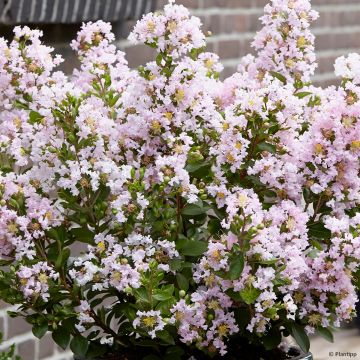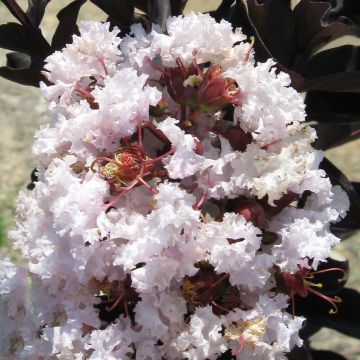

Lilas des Indes - Lagerstroemia indica Rhapsody In Blue


Lilas des Indes - Lagerstroemia indica Rhapsody In Blue
Lagerstroemia indica Rhapsody In Blue - Crape Myrtle
Lagerstroemia indica Rhapsody In Blue
Crape Myrtle, Crepe Myrtle, Indian Lilac
Special offer!
Receive a €20 voucher for any order over €90 (excluding delivery costs, credit notes, and plastic-free options)!
1- Add your favorite plants to your cart.
2- Once you have reached €90, confirm your order (you can even choose the delivery date!).
3- As soon as your order is shipped, you will receive an email containing your voucher code, valid for 3 months (90 days).
Your voucher is unique and can only be used once, for any order with a minimum value of €20, excluding delivery costs.
Can be combined with other current offers, non-divisible and non-refundable.
Why not try an alternative variety in stock?
View all →This plant carries a 24 months recovery warranty
More information
We guarantee the quality of our plants for a full growing cycle, and will replace at our expense any plant that fails to recover under normal climatic and planting conditions.
Would this plant suit my garden?
Set up your Plantfit profile →
Description
The Lagerstroemia indica 'Rhapsody in Blue' is a very lovely variety of indian lilac with a compact, upright habit. Its dark pink, somewhat purple flowering lasts all summer and into autumn, a time when few other bushes can compete with its generosity. It is also decorative due to its purple foliage, well matched to the colour of its flower clusters. Limited in growth and tolerating pruning well, this bush can also be grown in pots in the colder regions. It has all the qualities for adorning small gardens and terraces and will thrive in full sun, in fertile, light, not too dry soil.
The Indian Lilac 'Rhapsody in Blue' belongs to the small family of Lythraceae, known for also hosting the pomegranate (Punica granatum), of which there are flowering and fruiting species, as well as the Cuphea, some species of which are used as flowering perennials on the Mediterranean coast. These are indeed moderately to slightly hardy plants, with Lagerstroemia being one of the hardiest, since it resists temperatures down to -10°C to -15°C. However, it needs heat to flower, which limits its interest in northern areas, even though its bark becomes decorative over time, as the branches or trunk thicken. Indeed, in cool areas, it is most often present as a bush but in the south, you can come across specimens formed into trees.
'Rhapsody in Blue' is a compact variety, generally reaching 1.50 m (4 ft 11 in) in height. It has a very upright aspect, with fairly vertical branching. Its deciduous foliage, composed of medium-sized, slightly glossy ovate leaves typical of the genus, has a purple to burgundy red colour. Its flowering is remarkable, a superb dark pink, somewhat purple colour, covering the bush with a multitude of clusters. The very dense inflorescences are composed of fine pedicels each bearing a flower with five very undulate petals, the texture of which is reminiscent of a crepe, with a yellow heart forming a lovely contrast, but sometimes submerged by the mass of petals.
This Lagerstroemia grows in moist but well-drained soil and tolerates most types of soil, neutral to slightly acidic or calcareous. However, it absolutely needs a sunny exposure and must be pruned each year at the end of winter to flower well. It is indeed imperative to select the most vigorous shoots and prune them short (to 4 or 5 eyes) and to eliminate all the twigs and fine shoots that will not give any flowers. You can grow it in a pot on a terrace, or in very cold regions. You will then need to plan to water it regularly in summer because these living conditions are more rigorous than in the open ground, the roots cannot plunge into the soil to feed themselves.
Indian Lilacs are the glory of Southwestern gardens, some local nurseries have even specialised in them. Preferring the humid and hot southern Atlantic to the dry and windy Mediterranean, it nevertheless thrives well on the French Riviera provided it is watered in summer. This bush also deserves to be planted in the colder areas of our region, if necessary by installing it in a decorative pot so that it can be brought indoors during the coldest season. Its compact habit makes it well-suited to this use and the annual pruning necessary anyway allows it to be kept within a limited volume.
Its purple foliage encourages the creation of contrasts with shrubs with golden foliage. The Cotinus coggygria Golden Lady with its foliage in shades ranging from orange-yellow, to golden yellow in summer then turning orange in autumn will thus be a wonderful companion. The Physocarpus Dart's Gold will also be a very good choice, its white flowering in May-June preceding that of 'Rhapsody in Blue', and its golden yellow 3-lobed foliage creating a strong contrast. For a more subtle foliage contrast, the grey-green of the Caryopteris Grand Bleu will be ideal, while its dark blue flowering will accompany that of our Lagerstroemia.
NB : Karl Von Linnaeus named this tree in honour of his friend Magnus Von Lagestroem (1696 – 1759), who had sent it to him from India for identification. Originally, this tree was used to decorate Chinese temples. We would like to point out that this tree produces fruits that have a narcotic action if ingested.
Report an error about the product description
Lagerstroemia indica Rhapsody In Blue - Crape Myrtle in pictures




Plant habit
Flowering
Foliage
Botanical data
Lagerstroemia
indica
Rhapsody In Blue
Lythraceae
Crape Myrtle, Crepe Myrtle, Indian Lilac
Cultivar or hybrid
Other Lagerstroemia - Crape Myrtle
View all →Planting and care
We advise you to plant the Lagerstroemia indica 'Rhapsody in Blue' in the spring, when frost is no longer a threat, in a very sunny and sheltered situation, in rich soil, rather fresh, well-drained and if possible slightly acidic, neutral or a little calcareous. In the southern region, however, it would be better to plant it in the autumn so that it can benefit from the seasonal rains to root. It will appreciate a contribution of compost and a thick layer of dead leaves, especially during the first two winters in somewhat cold regions. It is necessary to prune the flowering branches very short in February-March, leaving only 3 to 5 buds to balance its branches and stimulate the growth of future flower-bearing branches. Also remove the feeble twigs that will produce no flowers and the poorly positioned branches.
Cultivation in a pot or in a large pot is possible, even recommended in regions where frost is severe and prolonged. This bush can withstand up to -15°C (5 °F) at its peak, or even more, once it is old enough and well established.
Planting period
Intended location
Care
This item has not been reviewed yet - be the first to leave a review about it.
Haven't found what you were looking for?
Hardiness is the lowest winter temperature a plant can endure without suffering serious damage or even dying. However, hardiness is affected by location (a sheltered area, such as a patio), protection (winter cover) and soil type (hardiness is improved by well-drained soil).

Photo Sharing Terms & Conditions
In order to encourage gardeners to interact and share their experiences, Promesse de fleurs offers various media enabling content to be uploaded onto its Site - in particular via the ‘Photo sharing’ module.
The User agrees to refrain from:
- Posting any content that is illegal, prejudicial, insulting, racist, inciteful to hatred, revisionist, contrary to public decency, that infringes on privacy or on the privacy rights of third parties, in particular the publicity rights of persons and goods, intellectual property rights, or the right to privacy.
- Submitting content on behalf of a third party;
- Impersonate the identity of a third party and/or publish any personal information about a third party;
In general, the User undertakes to refrain from any unethical behaviour.
All Content (in particular text, comments, files, images, photos, videos, creative works, etc.), which may be subject to property or intellectual property rights, image or other private rights, shall remain the property of the User, subject to the limited rights granted by the terms of the licence granted by Promesse de fleurs as stated below. Users are at liberty to publish or not to publish such Content on the Site, notably via the ‘Photo Sharing’ facility, and accept that this Content shall be made public and freely accessible, notably on the Internet.
Users further acknowledge, undertake to have ,and guarantee that they hold all necessary rights and permissions to publish such material on the Site, in particular with regard to the legislation in force pertaining to any privacy, property, intellectual property, image, or contractual rights, or rights of any other nature. By publishing such Content on the Site, Users acknowledge accepting full liability as publishers of the Content within the meaning of the law, and grant Promesse de fleurs, free of charge, an inclusive, worldwide licence for the said Content for the entire duration of its publication, including all reproduction, representation, up/downloading, displaying, performing, transmission, and storage rights.
Users also grant permission for their name to be linked to the Content and accept that this link may not always be made available.
By engaging in posting material, Users consent to their Content becoming automatically accessible on the Internet, in particular on other sites and/or blogs and/or web pages of the Promesse de fleurs site, including in particular social pages and the Promesse de fleurs catalogue.
Users may secure the removal of entrusted content free of charge by issuing a simple request via our contact form.
The flowering period indicated on our website applies to countries and regions located in USDA zone 8 (France, the United Kingdom, Ireland, the Netherlands, etc.)
It will vary according to where you live:
- In zones 9 to 10 (Italy, Spain, Greece, etc.), flowering will occur about 2 to 4 weeks earlier.
- In zones 6 to 7 (Germany, Poland, Slovenia, and lower mountainous regions), flowering will be delayed by 2 to 3 weeks.
- In zone 5 (Central Europe, Scandinavia), blooming will be delayed by 3 to 5 weeks.
In temperate climates, pruning of spring-flowering shrubs (forsythia, spireas, etc.) should be done just after flowering.
Pruning of summer-flowering shrubs (Indian Lilac, Perovskia, etc.) can be done in winter or spring.
In cold regions as well as with frost-sensitive plants, avoid pruning too early when severe frosts may still occur.
The planting period indicated on our website applies to countries and regions located in USDA zone 8 (France, United Kingdom, Ireland, Netherlands).
It will vary according to where you live:
- In Mediterranean zones (Marseille, Madrid, Milan, etc.), autumn and winter are the best planting periods.
- In continental zones (Strasbourg, Munich, Vienna, etc.), delay planting by 2 to 3 weeks in spring and bring it forward by 2 to 4 weeks in autumn.
- In mountainous regions (the Alps, Pyrenees, Carpathians, etc.), it is best to plant in late spring (May-June) or late summer (August-September).
The harvesting period indicated on our website applies to countries and regions in USDA zone 8 (France, England, Ireland, the Netherlands).
In colder areas (Scandinavia, Poland, Austria...) fruit and vegetable harvests are likely to be delayed by 3-4 weeks.
In warmer areas (Italy, Spain, Greece, etc.), harvesting will probably take place earlier, depending on weather conditions.
The sowing periods indicated on our website apply to countries and regions within USDA Zone 8 (France, UK, Ireland, Netherlands).
In colder areas (Scandinavia, Poland, Austria...), delay any outdoor sowing by 3-4 weeks, or sow under glass.
In warmer climes (Italy, Spain, Greece, etc.), bring outdoor sowing forward by a few weeks.
















































